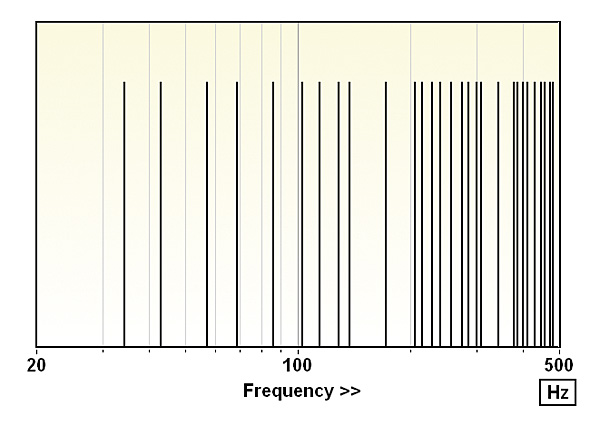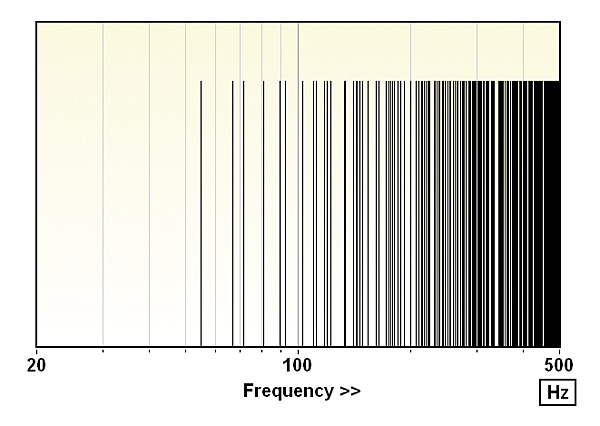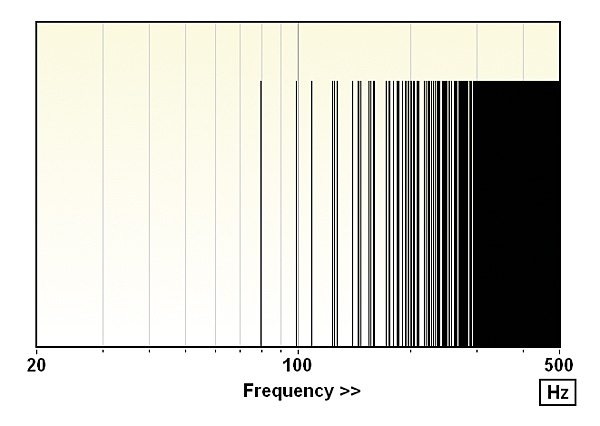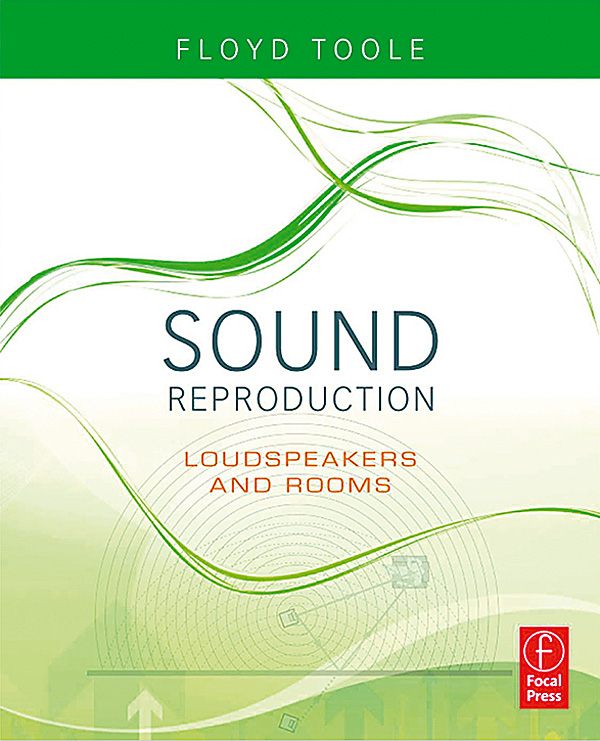Get Your Sub Singing! Page 2
À LA MODE
Boundary gain is not something to forget when positioning subs but even larger disruptions to in-room bass response can result from room modes, which do more than result in large peaks or dips in LF response at the listening position. Because room modes are resonances they also mess with time domain behaviour at lower frequencies, which can result in boomy, 'slow' bass, and may also interfere with pitch as a result of frequencies sufficiently close to a mode exciting the resonance which then 'pulls' the apparent frequency towards it.


We can visualise the first issue by modelling the effect of a room mode on a low-frequency toneburst. Fig 5a shows an unsullied 30Hz toneburst while Fig 5b illustrates what happens to it with a 30Hz room mode of high Q. (Q, short for 'quality factor', is a measure of the sharpness of a resonance's peaked response, being equal to the peak's centre frequency divided by its –3dB bandwidth. If a resonance is high-Q then it has low damping and takes a longer time to build up and to decay than a better-damped, low-Q resonance. But a high-Q resonance is stimulated by a narrower band of frequencies than a low-Q one.)
Sting In The Tail
Note how the resonance slows the onset of the toneburst as it builds up and also adds a decay 'tail', both of which features, if sufficiently pronounced, can result in a ponderous bass, particularly on transient material like that having fast runs on a double-bass or bass guitar.
In a rectangular (strictly, 'cuboid') room, modes come in three flavours: axial (which involve just one pair of opposing boundaries), tangential (two pairs of opposing boundaries) and oblique (all six boundaries). If we return to our example 5x4x3m room, the modal frequencies of which were shown in Fig 2, and graph the axial, tangential and the oblique modes separately, we obtain Figs 6a, b and c. What's obvious from these is that the axial modes – which are usually the most prominent – are relatively few in number (33 of them up to 500Hz) and reach down lowest in frequency (the fundamental length mode is at 34.3Hz). The tangential and oblique modes are more numerous (277 and 632 respectively up to 500Hz) but begin at higher frequencies: the first tangential mode is at 54.9Hz, the first oblique mode at 79.3Hz.



This amounts to both bad news and good news. The bad news is that at bass frequencies there is only a thin scattering of modes, so in-room bass response is almost certain to be uneven. In the 5x4x3m room if a subwoofer works up to 50Hz, its passband will encompass just two axial modes (the fundamental length and width modes) at 34.3Hz and 49.2Hz, and no tangential or oblique modes. The good news is that this makes the modal patterns easy to visualise, and it's simpler to envisage how changing subwoofer and listener position will affect results.
Moving the listening position and/or sub position nearer to the room centreline in either case will reduce the response peak associated with that resonance. Room treatment usually won't help much. Ideally the LF resonances would be well damped in order to make their peaks broader and the combined response smoother. Rooms with large window areas and a suspended wooden floor will usually have more inherent LF damping than those with stiffer boundaries, but adding significant acoustic damping to a room at low frequencies is generally impractical.
If you're using a single subwoofer I suggest you start your placement experimentation by locating it centrally against the front wall. Then try moving your listening position forwards and backwards and the sub progressively along the front wall towards one corner to find the optimum combination. With twin subs you can expect to achieve better results over a larger listening area than with a single sub. Begin with the subs placed in either front room corner and experiment with moving them closer together along the front wall or forward along the side walls to find the best location, remembering always to experiment with listening position too, although this will be constrained by the imperative to achieve good results from the main speakers. For the listening, be sure to use music tracks that have both sustained bass notes and fast bass runs. Two examples are Jennifer Warnes' 'Way Down Deep' [Private Music 01005-82089-2] and Chris Jones' 'Fender Bender' [Stockfisch SFR 357.6027.2].

Electronic equalisation of subwoofers can make worthwhile improvements to performance, but should never be used in an attempt to rescue the consequences of poor positioning. Get the positioning of the sub optimised first and then, if necessary, apply EQ.
Various methods of applying EQ exist: some subwoofers incorporate manual or automatic EQ within their electronics; digital room correction systems, which generally apply equalisation to higher frequencies than just the bass, are available in the form of hardware or, for computer audiophiles, software. The use of hardware or software parametric equalisers can be effective too, although with these you have to set centre frequency, level and Q manually to control troublesome modes.
The golden rule, as with all loudspeaker EQ, is never use it to try to fill a deep notch in the in-room frequency response. If such a notch exists, move the subwoofer and/or listening position to eliminate it. Use the EQ only to suppress peaks.
Stereo Or Mono?
There is a long-standing controversy in the audio industry over whether twin subs should be operated independently – one fed the left channel signal, the other the right channel signal – or both fed a mono signal. Proponents of the first arrangement claim that the sense of image spaciousness is thus improved. Proponents of the latter respond that there is no such influence below 80Hz, which is generally regarded as the upper frequency limit for a subwoofer's location not to be discernible.
Academic opinion generally sides with the second point of view. In his book Sound Reproduction (first edition), room acoustics guru Floyd Toole – in three paragraphs under the sub-heading 'Stereo Bass: Little Ado About Even Less' – dismisses the idea, provided that the mono-ing of bass is limited to a maximum of 80Hz. Many recordings, indeed, have mono or almost-mono bass – although not all – and it was standard practice in the days of LP to mono bass frequencies to limit the vertical motion of the cutting and pick-up stylus.

If you use twin subwoofers located to either side of the room, and so could run them in stereo mode, I suggest that you experiment to decide this issue for yourself. (I do not have sufficient experience of this to offer any opinion.)
If you do use stereo subwoofers then logically the sum (L + R) and difference (L − R) components of the stereo signal will require different degrees of equalisation to optimise performance (and to make any comparison with the mono option fully valid). However, there are few, if any, subwoofer EQ regimes that provide for this capability.
High-Pass
Subwoofers are conventionally used to 'fill-in' below the inherent bass roll-off of the main speakers. This makes sense in that no filtering is inserted into the main speaker feed, but it squanders one of the principal potential benefits of a sub: reducing the main speakers' distortion and increasing their output capability.
To achieve these benefits requires the subwoofer to shoulder as much of the bass burden as it practicably can. If you have small main speakers with a high bass roll-off, there's probably nothing that can be done to assist them. Whereas if the main speakers roll off lower in frequency, the subwoofer could – and in an ideal world would – be used to lighten their load. This involves inserting a high-pass crossover into the main loudspeaker feed at around 80Hz if using a mono subwoofer, potentially higher in frequency if using stereo subs, and configuring the subwoofer to fill in below the higher roll-off point.
This is not a simple thing to execute well in practice, and so is rarely employed – one exception being the DSP/active KEF LS50 Wireless [HFN Oct '17], where all the variables can be properly controlled. It's a pity because the potential benefits are significant. If the main speakers are relieved of just half an octave of bass extension, bass driver excursion requirement is reduced by about half; if relieved of an octave, bass driver excursion is roughly halved again. This is of particular benefit in two-way speakers where the bass driver works up to, typically, 3kHz, where it crosses over to the tweeter. Reducing the bass driver's excursion doesn't just lower low-frequency distortion: more importantly, it reduces intermodulation distortion throughout the working range.

























































